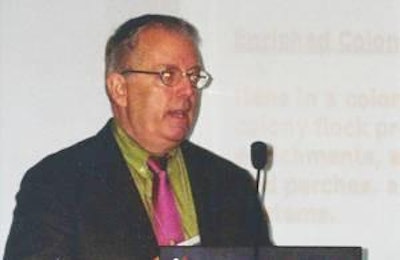
Tim Amlaw, director of the American Humane Association (AHA) Farm Animal Program, reviewed the involvement of the AHA in agriculture at the recent Northeastern Conference on Avian Diseases. The AHA has a long history of participation in animal production commencing in 1877 with the introduction of the 28-hour law mandating humane transport of livestock. The AHA was instrumental in motivating the 1958 Humane Slaughter Act and more recently established standards and a certification program for housing livestock, including laying hens. At the present time, the AHA has certified 58 producers at 576 locations in all major poultry producing states.
Amlaw addressed aviaries and enriched colony cages as the most important development areas in the industry. The specific requirement for stocking density, arrangement of modules and application of adequate feeding, dust bathing and nesting were detailed and are available from the AHA.
Establishing standards and criteria for certification allows producers and equipment manufacturers to coordinate their planning, design of housing and installations and to establish programs for the orderly replacement and upgrading of existing facilities and establishing new units.
The enriched colony cage, developed in the European Union (EU), is undergoing scientific evaluation in the U.S. In view of the uncertainty of the future state welfare initiative regarding housing of hens, a number of companies have elected to install enrichable cages. These modules can function at the 67-square-inch density at the present time. If circumstances warrant, enrichments can be added and stocking density can be adjusted to 116 square inches per hen. This would allow producers to comply with customer initiatives and to conform to anticipated export regulations, harmonizing EU requirements with those in exporting countries.
Amlaw forecasts that by 2017, up to 35% of caged housing in the U.S. will be in either enriched or enrichable configurations.

















